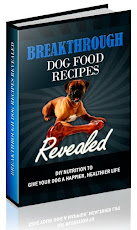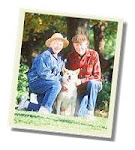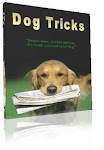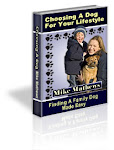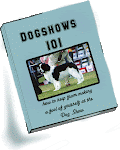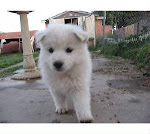
 No dog gets through life without fleas.
No dog gets through life without fleas. Fleas are an especially big problem if a dog is allergic to flea bites. Many dogs are. Some breeds, like Golden Retrievers, are allergic to flea bites all their lives. Dogs often become more sensitive to flea bites as they age because older skin is drier and an aging immune system weaker.
Even though your dog may have gone through puppyhood and most of the adult years with barely the flick of a paw at a flea, the senior years are different. Flea control becomes increasingly important as your dog ages.
Some people insist they have no fleas in their home or on their dog. They've never seen a flea nor been bitten. Yet, even as they insist they are flea-free, their dog hangs out with bare hind-quarters and several festering hot spots on his body, scratching madly at his undercarriage. Owner denial or lack of awareness is common.
Fleas are hardy and prolific. They like a temperate, moist climate best, but they can go into a dormant state for as much as a year, waiting until conditions for survival and reproduction are more favorable. They live (or lie dormant) in carpets, furniture, bedding, floor and wall joints, indoor plants, gardens, and yards. They like the cozy, moist places around bushes in your garden. They like the car, too, if the dog goes for rides in it.
Here is the plan of attack to keep fleas under control:Attack the fleas on your dog and any other pets who live with you.
Attack the fleas in your home.
Attack the fleas in the yard, garden, and car.
The advertising literature for some flea control products makes it sound as though your problem will be solved by using just one method of flea control. One method alone usually will not work. Use this three-part plan of attack. It's the best way to achieve good results.
Attack Fleas on Your DogUsing brush and flea comb on a daily basis will help you to discover any fleas that may be living on your dog. However, you will still need to use agents to repel, kill, or affect the reproductive cycle of the fleas. With an older dog, it is wise to use the gentlest and least invasive methods.
Controlling fleas is big business. Major drug companies are focused on it, and, in the past few years, have developed some outstandingly effective substances. "Program" (Ciba Geigy Corp.) is a once-a-month tablet you give your dog. It acts when a flea bites. The flea ingests the pet's blood, which contains the drug in "Program" (called "lufenuron"). This drug prevents the flea's eggs from developing, ending the reproductive cycle. An "Ovitrol" collar also works by preventing flea eggs from hatching.
The active ingredients in Program and Ovitrol are "Insect Growth Regulators," or IGRs. These aren't designed to kill anything directly, but rather to interrupt the reproductive cycle of insects. The disadvantage to these products is that adult fleas are still free to bite, and an allergic dog will still react.
Two products that kill fleas but that appear to have no adverse side effects are: (1) Advantage (Bayer), which is applied to a pet's skin -- a few drops between the pet's shoulder blades -- once a month. Fleas that get onto the pet die within a few hours of being exposed to the drug in Advantage; and (2) Frontline (Rhone Merieux), which acts in a similar way.
Don't use flea collars with insecticide content. They are not effective and can be harmful to your dog. A better use for a flea collar is inside your vacuum cleaner bag. There it will kill any fleas you vacuum up around the house. When it comes to ultrasonic flea collars, we've heard they don't work.
Don't "dip" or "flea shampoo" your dog; the ingredients in such preparations are too harsh, especially for an older dog.
Attack the Fleas in Your HomeMost fleas spend most of their time OFF your dog, jumping on just long enough for a meal. The rest of the time they live somewhere in the environment. That is why you need to vacuum furniture and carpets often. Use washable bedding for your dog and wash it at least as often as you wash your own. Dry the bedding on high heat (anything above 95 degrees will kill flea pupae). Treat your home with your choice of a flea control agent or use a professional exterminator three to four times a year if you live in a temperate climate, or at least twice during spring and summer.
Select the least toxic chemicals available. The company known as "Fleabusters" uses a non-toxic powder that is very effective. If you use a traditional exterminator, ask about the chemicals they employ. "Precor" is in the IGR class and is considered fairly non-toxic. Pyrethrins and pyrethroids, though somewhat toxic, are common and considered safe when properly applied. Organophosphates are also safe as long as you don't have exposure to them while they are still wet.
The flea-control professionals usually can do a better job than you can do yourself. If you have been doing it yourself and your dog is still scratching, try a professional. Get a recommendation from your vet or from friends. Safe and effective application depends a great deal on the "professional" doing the job. Be sure the person or company is experienced and has a good track record.
Attack Fleas in the Yard, Garden, and CarThere are many choices for do-it-yourselfers to apply to the yard and garden. A class of substances called "wettable powders" can be used effectively. "Dursban" is an example. "Diazinon 25%" is a spray-pesticide that is effective. One problem with these pesticides, however, is that they don't discriminate among insects, and will be as lethal to ladybugs as they are to fleas.
There are some non-toxic alternatives to use in the garden. Diatomaceous earth is a drying agent that creates an inhospitable environment for fleas (available at garden supply stores). Another is a biological substance known as a "nematode" that kills flea eggs and pupae. Sold commercially as "Flea Halt!" and "Interrupt," nematodes are not effective on adult fleas, so, in a cold climate, you need to apply them in the spring, before the eggs have begun to hatch. In a temperate climate, you will need to apply them three to four times a year.
You can spray or "bomb" your car yourself; however, if you don't ventilate the car adequately afterwards, exposure to the poisons in these preparations will be dangerous. Try vacuuming thoroughly first. Then use diatomaceous earth on the carpets and upholstery inside the car. Leave it on overnight, and vacuum again before using the car.
Consider a professional to do your yard, garden, and car at the same time as the interior of your home is being treated.
Consult Your Vet and Personalize Your Flea-Control ProgramConsult your vet to decide on the best products to use with your dog. The cost of a visit and the purchase of products from your vet is a good investment. Your vet will have the latest information on flea control products, and will also know if your dog is on medication or has a condition that would be compromised by using a particular flea control method. What works for another dog -- who may be younger and in a different state of health -- may not be right for your senior dog.
If you have a personal leaning toward more "natural," environmentally-safe methods, be sure your vet has the same point of view.
Your own lifestyle should also affect your choices. Flea control requires time and energy, so try to plan a program that is convenient for yourself.
A personalized and convenient program -- including an atack on all three fronts -- is one you are likely to follow. It will make a big difference in your senior dog's overall state of health and, in the end, is likely to save you time and money you would otherwise spend in extra trips to the vet.
Tick ControlIn attacking fleas, you will also be controlling for ticks. Ticks are problematic because they cause illnesses like Lyme disease, Rocky Mountain spotted fever, and Erlichia. Ticks especially like to attach themselves to your dog's face, ears, legs, paws, chest and abdomen. Check these areas carefully by running your hands deep into the fur, along the surface of the skin.
You will need to use care in removing a tick from your dog so that you do not leave behind a big part of the tick's body. A tiny particle of the body will not be problematic, but any large piece may cause illness or infection. If the tick is not deeply embedded, you can kill it by applying a pyrethrin spray directly to it. If the tick doesn't fall off within a day, use a pair of tweezers (rather than your bare hands), grasping the tick as close to its head as possible. Pull straight out. Then clean the site on your dog's body with soap and water or alcohol, and apply Neosporin or another antibiotic ointment.
If you are unsure about whether you have successfully removed the tick, see a vet. Tick-borne illnesses like Erlichia can be extremely serious.











